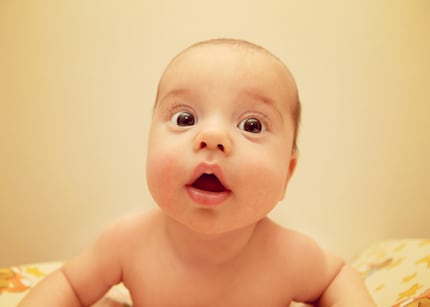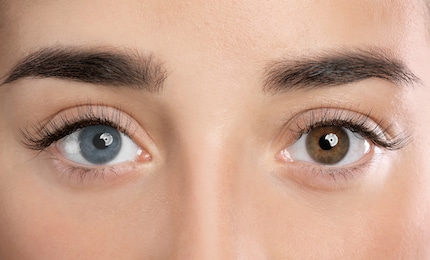
Background information
Fact or fiction? Exploring the co-pregnancy of fathers
by Katja Fischer

Expectant and new parents are often confronted with a deluge of baby-related «wisdom». So, which of these nuggets of advice actually hold true? And which ones are nothing but humbug? I’ve decided to put these myths to the test. This time, I’m tackling the notion that all newborns have blue eyes.
You’ll remember your parents’ wisdom for all of your life. For instance, my mum used to say: «All babies have blue eyes when they’re born. Their real eye colour doesn’t develop until later.» That stuck with me. I believed it too. It’s also been confirmed to me many times over. All the newborns I’ve ever seen in person have had blue eyes. Most of them dark blue.
I’ve got to admit that my own eyes were like saucers when researching this article. My mum and I were just so wrong. Well, about some things.
In our defence, the blue-eyed baby myth is a common and enduring one. And in Switzerland, it really is easy to get the impression that all babies have blue or at least faintly blue eyes.
This, however, is down to the fact that fewer people in Switzerland have dark skin. In Europe and North America, the majority of babies really are born with blue eyes. In Africa, Asia and South America, on the other hand, most babies already have brown eyes at birth.
That’s because of the presence of the pigment melanin. Children born into northerly climes that don’t get much sunshine have very few melanin pigments in their eyes at birth. At first, you only see the base colour: blue. After they’re born, melanin production kicks in properly, allowing the child’s real eye colour to be established within their first year of life. It takes some time for the pigment to be completely deposited.
In southerly countries, however, babies’ eyes develop protection from strong sunlight while they’re still in utero. Melanin absorbs the sun’s rays, so babies born in sunnier countries have darker eyes from birth.

Does this mean that babies with blue eyes are less protected against UV rays? Yes and no. This Bern-based ophthalmology practice (page in German) says it’s wrong to claim blue eyes have a biological disadvantage. Apparently, it’s the exact opposite. «Less melanin means more sunlight gets through. This is an advantage at northern latitudes because sunlight is needed to produce vitamin D.»
Whether a child’s eyes are blue, green or brown ultimately depends on the concentration of melanin in the iris. Blue eyes have very little melanin, green eyes have slightly more and dark eyes have a lot of it. Genes determine melanin production and, subsequently, eye colour.
So, how come parents with brown eyes have children with blue eyes? It’s all down to gene combination. A distinction’s made between two types. There’s the phenotype, which is responsible for externally visible characteristics. Then there’s the genotype, which consists of genetic information available in two forms – one from the mother and one from the father.
If both parents pass on the «blue» information, their child will have the blue/blue genotype and blue eyes as the phenotype. If the mother inherits the «blue» information and the father the «brown», the child will have the blue/brown genotype and brown eyes. That’s because brown is dominant over blue (see the «Rarest eye colour in the world» infobox). However, if the child grows up to have children of their own, they could either pass on the «brown» or «blue» information carried inside them. That’s why it’s possible for parents with brown eyes to have blue-eyed children.
Very rarely, people have two different coloured eyes (1 in 250,000). Known as heterochromia, this phenomenon is caused by a disturbance in the pigmentation of the iris, with one eye receiving less melanin than the other. However, it’s a harmless condition. It’s simply one of nature’s whims.

Speaking of nature’s whims (or is it fate playing a trick on me?), my mum’s trying to reach me as I write this. Mum, I’ll call you back! And boy, have I got news for you about newborn babies’ eye colour ...
In our Fact or Fiction? series, I put baby-related pearls of wisdom and whacky pregnancy theories under the microscope. Previously published:
Mom of Anna and Elsa, aperitif expert, group fitness fanatic, aspiring dancer and gossip lover. Often a multitasker and a person who wants it all, sometimes a chocolate chef and queen of the couch.
Interesting facts about products, behind-the-scenes looks at manufacturers and deep-dives on interesting people.
Show all